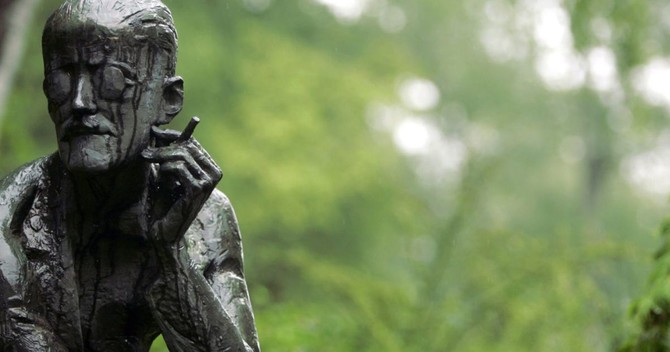NEW YORK: One of the foremost private collections of works by the influential Irish writer James Joyce has been donated to New York’s Morgan Library and Museum.
The 350-piece collection includes numerous signed and inscribed first editions, photographs, posters and manuscripts, including a fragment of his magnum opus “Ulysses” and rare pressings of 78 RPM recordings of the author.
The collection was assembled by New York gallery owner Sean Kelly and his wife Mary.
“It is difficult to summarize in a few words the importance of this extraordinary gift to the Morgan Library & Museum,” said museum director Colin Bailey.
“It adds enormously to our small but distinguished Joyce collection, and instantly establishes the Morgan as a major center for scholarly research related to the author’s life and work.”
The museum is planning a public exhibition in 2022, the centennial of the publication of “Ulysses.”
Joyce’s life and works are also commemorated at the James Joyce Center in Dublin and in a collection at the University of Buffalo.
The Morgan Library is the former private library of John Pierpont “JP” Morgan, a central figure in the world of finance at the turn of the 20th century.
It was opened to the public by his son following his death and has since become a museum focused on literature.
James Joyce collection donated to New York library
James Joyce collection donated to New York library

What We Are Reading Today: ‘Crossing Thoughts’

Author: Sultan Ayaz
“Crossing Thoughts” is a fantasy novel in English by Saudi author Sultan Ayaz, published in 2017.
Ayaz’s novel is about humans defending their homeland against demon oppression. It is about the eternal fight between humanity and demons, and the person who stands between them.
The story begins with Drake, a child who lives a peaceful life with his family in a small town. However, a demonic attack destroys the village, but Drake somehow survives.
Three characters emerge: Aria, Ray and Amber, who study the nature of elements at the Grand College of Elements in the Kingdom of Iora, one of three kingdoms suffering demonic oppression. They learn to employ elemental magic as a weapon against their demonic opponents.
Aria (wind element user), Amber (fire element user) and Ray (thunder element user) end up fighting a sea demon and are discovered by a mysterious man called Soul, who admires their powers and helps them train to become “demon slayers,” to free humans from oppression.
There are many fight scenes in the storyline using magic and elements, and the book is full of drama, plot twists and terror.
What I liked about the narrative is how easy it is to read and follow, and the development of the world building —from the village to the Kingdom of Iora.
The female characters in the novel shine brighter and have distinct styles, making them more intriguing to read about, and each possesses a particular power.
It might be confusing for some readers that the story begins with Drake’s perspective and then cuts to the story of Aria, Amber and Ray. However, the more you read, the more intriguing the female storylines become.
The book has received four-plus star ratings on the Goodreads website and is simple enough to read in one sitting.
In 2020, Ayaz became one of the first Saudi novelists to have a fiction work in English published overseas when Olympia Publishers, a British publishing house, purchased the rights to “Crossing Thoughts.”
The novel is also set to be adapted into a Manga comic by Manga Arabia.
What We Are Reading Today: When the Bombs Stopped

Author: Erin Lin
Over the course of the Vietnam War, the United states dropped 500,000 tonnes of bombs over Cambodia—more than the combined weight of every man, woman, and child in the country.
Fifty years after the last sortie, residents of rural Cambodia are still coping with the unexploded ordnance that covers their land.
What We Are Reading Today: Father Time

Author: Sarah Blaffer Hrdy
It has long seemed self-evident that women care for babies and men do other things.
Puzzled and dazzled by the tender expertise of new fathers around the world— several in her own family—celebrated evolutionary anthropologist and primatologist Sarah Blaffer Hrdy set out to trace the deep history of male nurturing and explain a surprising departure from everything she had assumed to be “normal.”
What We Are Reading Today: ‘Breaking the Mold’

Authors: RAGHURAM G. RAJAN AND ROHIT LAMBA
India’s economy has overtaken the United Kingdom’s to become the fifth-largest in the world, but it is still only one-fifth the size of China’s, and India’s economic growth is too slow to provide jobs for millions of its ambitious youth.
In “Breaking the Mold,” Raghuram Rajan and Rohit Lamba show why and how India needs to blaze a new path if it’s to succeed.
What We Are Reading Today: ‘The Things You Can See Only When You Slow Down’

Author: Haemin Sunim
“The Things You Can See Only When You Slow Down: How to be Calm in a Busy World” offers advice on how to find inner peace in today’s busy world.
The 300-page book, published in 2017, was written by Haemin Sunim, a Korean Buddhist monk, and has sold more than 3 million copies.
The author underwent monastic training in South Korea before spending seven years teaching Asian religions at Hampshire College in the US. The book elaborates on the wisdom he gained from personal experiences as a Buddhist monk.
One of the book’s strengths is its simplicity. The author’s writing style is easy to understand as he presents his ideas in bite-sized chapters, each focusing on a different aspect of mindfulness.
Whether he is writing about the meaning of silence or of gratitude, Sunim’s words resonate with a quiet authority which prompts the reader to pause and reflect on their own lives.
In addition, the book is filled with amazing imagery that complements the stories. The beautiful drawings contribute to Sunim’s narrative and create a sense of serenity and peace.
The author emphasizes the concept of enjoying the little things in life to the fullest, such as drinking a cup of tea in the morning, taking a walk in nature, or having a thoughtful conversation with loved ones.
Slowing down allows people to notice the happiness hidden in even the simplest tasks and moments, he claims.
He also encourages readers to be kind to themselves and offers advice on how people can develop a deeper sense of self-acceptance and self-love, fostering emotional well-being and resilience.
Sunim’s wisdom and compassion are clear. His words remind readers that despite the noise and distractions of the modern world, true happiness can be found when they slow down.
















